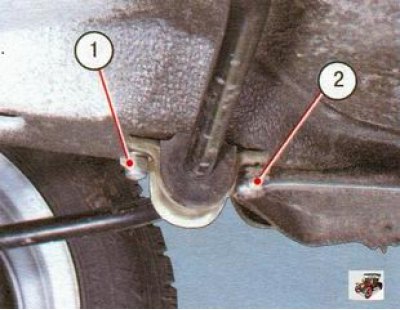
2. Turn away on one nut of fastening of racks of the stabilizer from both parties of the car.

3. Turn away two nuts of fastening of arms of a bar of the stabilizer of cross-section stability, from both parties of the car.
4. Remove arms and a bar of the stabilizer of cross stability together with racks.

5. If it is necessary to replace only the anti-roll bar struts or their bushings, unscrew the nuts securing the struts to the arms and knock the struts off the anti-roll bar with a wooden or polymer hammer.
6. Examine a bar of the stabilizer of cross-section stability. It should not be deformed, the ends should be in the same plane. If the geometry changes, replace the anti-roll bar. If the stabilizer pads are worn, torn, loose, or loose on the stabilizer bar, replace them.
7. Examine racks and plugs of the stabilizer of cross-section stability of a suspension bracket. Replace deformed stanchions and bushings if they are worn, torn, cracked, loose, or loose on the stem.

8. Install the anti-roll bar on the car and tighten the nuts 1 and 2 for fastening the brackets of the stabilizer pads until the gap in the sections of the pads is eliminated (if the pillows are split). Tighten the front nuts first (from the side of the cut), then back.
9. Wrap nuts of fastening of racks before a choice of backlashes between racks and levers. Finally tighten all anti-roll bar nuts with the suspension loaded (the car is on the ground). The moment of an inhaling of nuts of fastening of a rack 43-53 Nm (4.3-5.3 kgf·m), bracket mounting 13-16 Nm (1.3-1.6 kgf·m).
